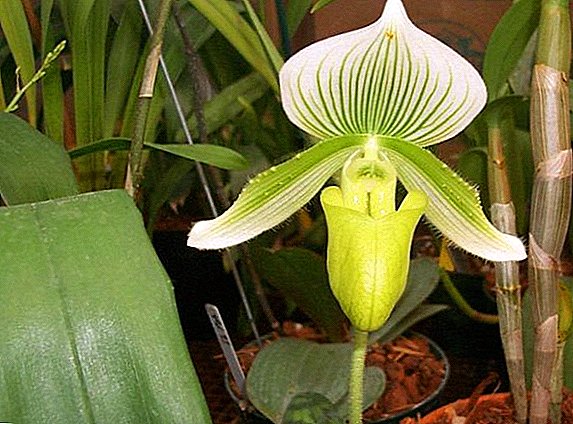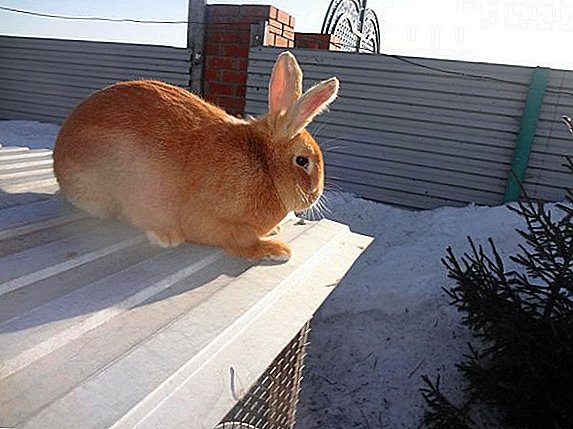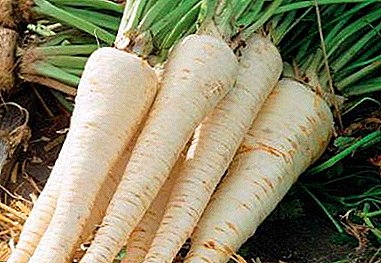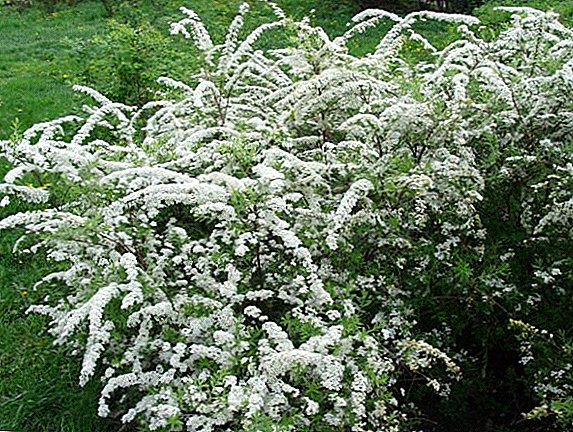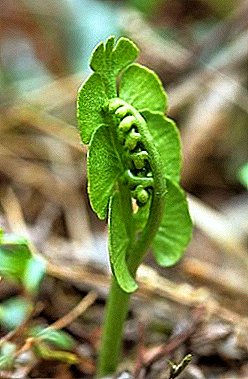
Long ago, our planet was covered with thickets of primitive ferns - grapes, plants that do not have a stem or leaves.
Straight from the root grew flat carved branches-fronds, ending in a narrow panicle in which spores matured. Relic has survived to our days, and now it can be found in different parts of the world.
Perhaps this particular fern was searched on the night of Ivan Kupala: at the ends of the frontier, sporangia grow, similar to a panicle of flowers.
The closest relatives of Grazdovnik is the Uzhnikov fern.
History of
Considering the fact that the city tree belongs to ferns, the history of its appearance goes back deep into the centuries. Ferns grew on Earth from time immemorial. People believed that the city can give insight and the ability to find treasures to the person using it. Therefore, the popular name of the plant: key-grass. Also visually, the part of the plant wrapped in the vegetative segment resembles a small key. The species name "semilunar" plant received for a semicircular shape and a yellowish-green shade of parts of the vegetative and spore-bearing parts.
Kinds
If you want to determine the type of the crescent tree found in the forest, checking it with a photo of the botanical reference book, you can make a mistake in the classification. These plants are very variable, they can change color and shape, interbreed with each other. In Russia, there are 8 varieties of grapes.
Virginia
It is found in the north of the European part of Russia and in Siberia in wet forests. It reaches a height of 45 cm, the entire above-ground part is covered with down. Fronds are dark green with overlapping extreme segments. In America, also referred to as a pointer, it is believed that with the help of this grape we can determine where dwarf ginseng grows. Often used in landscape design.

Lanceolate
Occurs in Siberian forests, reaches a height of 25cm. The fronds are smooth, thick, the lower pair of feathers has deep cuts with teeth.

Partitioned
It grows almost all over the globe except for deserts, in Russia it is found in forest areas on wet soils. Height up to 25 cm fronds die off in the middle of summer after a ripening spore. Received the name because of the highly dissected leaves. Often used in landscape design.
Photos subspecies Multipartite:
Semilunar
It is found almost throughout the entire territory of Russia; it does not form large colonies. Dwarf plant, does not exceed 20 cm, and the smallest specimens have a leaf length of only 4 cm. The name is given for a semi-lunar form and a yellow-green shade of the segments.
Fronds are not trimmed, after maturation of the dispute they die off. This type is often used to design alpine slides. Another name for the crescent moon is a key-grass. It is believed that he helps to search for treasures.

Chamomile
It is rarely found in Russia, mainly in the northern regions of the European part. Listed in the Red Book of Belarus and Moscow region. Some specimens reach a height of 30 cm. The lower part of the frond is reddish, the upper feathers are shortened and merge.

Plain
Rare plant listed in the Red Book of Russia. It is found in the northern regions of the European part of our country. Favorite habitat - near the coast of the seas and lakes. There is a hypothesis that this species is derived from the crossing of partitioned and semilunar grapes. Dwarf plant, reaching only 15 cm in height.
Photo subspecies Simple:
Northern
It is found in the Asian part of Russia, loves wet meadows. Height of the aerial part is up to 20 cm. The lower part of the frond is thickened. Feathers are bare, ovate, without cuts, only the lower pair is sometimes dissected.

Strong
Grows in forests and meadows of the Far East. Covered with a rare white fluff, the fronds reach a height of 25 cm. The petioles are thick, oval feathers with denticles at the edges.

Mountain
It grows in coniferous forests of western North America. View listed in the list of rare and endangered plants. The entire aerial part consists of a single gray-green leaf, not exceeding 8 cm.
Photos subspecies Mountain:
Southern
Grows in Australia and New Zealand. Large plant up to 50 cm in height with delicate pale green fronds.

Jenman
Very rare species described in 1900 Now there are several places of its growth: in the Dominican Republic, in Haiti and Jamaica.
Photos of the subspecies of Jenman's Hulk:
Many species are so rare and little studied that they can be described only in special scientific works. Most of them do not even have the usual name, and one Latin designation. Russian name is just a few grapes:
- strange;
- pharmacy;
- Tibetan;
- sticking;
- sheffner;
- dusser.
Home care
The hilar will decorate any room, but you need to consider that this the plant is very capricious, requires constant attention.
If you have to leave the house for a few days, the flower may die without regular watering and spraying.
Features care after purchase
Grozdnik does not tolerate overdrying. If you purchased a potted plant, cover the ground with moss as soon as possible to retain moisture. You can also place the vessel in a larger container, and fill the empty spaces with wet peat.
If you buy fern without packaging, choose a specimen with a large lump of soil that completely covers the underground part. Place the grapes in a pot carefully, the less the roots feel the change in conditions, the better the plant will take root.
Lighting
Hulk need light, but it does not tolerate direct sunlight. Put the plant on the window, where the sun will illuminate it only in the morning or in the evening. If the apartment has only south windows, apply a fern.
In the summer you can take it to the loggia, put the pot on the floor so that the sun's rays do not fall on it. You are going to the cottage - take your pet for a walk, in the shade of the trees it will be fine.
Temperature
Hulk loves moderate warmth. The most comfortable conditions for them are rooms with a temperature from + 15 ° to + 20 °.
When it gets colder + 10 ° or hotter + 22 °, plants can stop growing.
Your pets are not so dangerous cold or heat, as sudden changes in temperature, avoid places where they can fall under the gusts of cold wind.
Air humidity
Ancestors of grazdovnikov lived in a tropical climate, these plants still need high humidity. In urban apartments it is often too dry, moisten the space around the fern with artificial methods.
If there is an aquarium at home, put a pot next to it. Another solution: put wet clay in the pan. Twice a day, spray the leaves with water, and in hot weather, this procedure should be increased to five times.
Watering
At the roots of grazdovnikov no special hairs, and the whole system is at a shallow depth. Because of these features, they can not take water from the soil and require regular watering.
Be careful: in dry soil the plant will quickly die, and with excessive moisture, its roots will rot.
The easiest way to check - touch the ground with your finger. If hands need to be washed after that, watering is not required; if the grains were shaken off without a trace, the soil dried out.
Chlorine and lime are bad for the plant, it is better to water it with melt or rain water at room temperature. In the rest period, the breaks between watering should be increased.
Top dressing
 Clusters need feeding, but do not overdo it. In the summer, fertilize no more than once every two weeks, and during the rest period - once a month.
Clusters need feeding, but do not overdo it. In the summer, fertilize no more than once every two weeks, and during the rest period - once a month.
Fine, if you can buy a special composition for ferns; if this is not found, use slurry or ammonium nitrate solution (1 teaspoon per liter of water).
When choosing a fertilizer, see that the composition does not increase the acidity of the soil.
Transfer
These types of ferns poorly tolerated transplant. Do this work when the container becomes small and the roots fill the entire volume.
Remove the plant with a lump of earth and place it in a larger pot, trying not to disturb the roots. If you do not find a special soil for ferns in the store, mix equal parts of fertile land, peat and sand with the addition of expanded clay to retain moisture. At the bottom, fill in fine gravel for drainage.
Pruning
Green fronds do not require pruning, a period of peace will come, and they will die off. Remove dried parts and leave the plant to rest. If you forgot to water the vine and the leaves are dry, try to reanimate your pet. Cut off the dead above-ground part, moisten the soil and place the pot in a bright place.
Breeding
Even the usual cultivation of grapes in the home requires great care, and the cultivation of these plants - very hard work. There are several methods of breeding ferns, which one is better for these flowers?
Shoots
It is useless to try prikopat vayi in the ground. There are no growth buds on the leaves of the grasseur; they will not produce shoots.
Division
In the spring, many fern bushes can be divided into several parts.
With grazdovnikom such a procedure is best not to conduct. Its roots do not tolerate any effects, and after such an operation it is possible not only not to get new copies, but also to lose the main plant.
Tubers
In nature, the grasses often breed by root suckers. You can try to carry out such an operation during transplantation, but, as in the previous case, you risk being left completely without a plant.
Disputes
 The safest way: although it is unlikely that sprouts will appear, but the plant itself will not suffer. In the middle of summer, small tubercles form in the lower side of the frond, in which spores mature. When the spores are browned, cut the leaf and dry it.
The safest way: although it is unlikely that sprouts will appear, but the plant itself will not suffer. In the middle of summer, small tubercles form in the lower side of the frond, in which spores mature. When the spores are browned, cut the leaf and dry it.
Before sowing in a room where there are no drafts, shake the sheet or scrape the hillocks. The best time for sowing is the beginning of spring. Take 2 parts of peat and one part of leafy soil and sand, sterilize the composition, moisten it, sprinkle the spores and close the lid.
In nature, plants originate with a certain type of soil fungi, add a little soil to the soil, taken from under the grapes growing under natural conditions. Keep the vessel at 20 °, shoots will appear in 1-2 months.
There are male and female organs on the sprout so that fertilization takes place and asexual groundflower begins to develop, keep the ground and air in high humidity, the dishes should be closed and in the shade. Periodically open the tank for airing. When the intensive development of the leaves begins, plant the plants in a permanent place.
Diseases and pests
Pests are dangerous: scypherite fern, mealybug or aphid. Regularly inspect the leaves, noticing the damaged areas, process karbofosom or a special preparation.
Chemical composition and beneficial properties
The hilar contains in its composition:
- Flavonoids;
- Quercetin;
- Kempferol;
- Squirrels;
- Alkaloids;
- Ficilic acid;
- Vitamins C, E, A, B;
- Tannins;
- Glycosides and catechins;
- Fatty and essential oils.
The plant has hemostatic and antiseptic properties, and is also able to deal with manifestations of dysentery, heal wounds, ulcers and burns. It is used as an antidote for snake bites. Also the cemetery can be used as an anthelmintic agent.
The use of flowers in traditional medicine
 Recipes and ways to use the plant from various ailments:
Recipes and ways to use the plant from various ailments:
With a snake bite:
- The plant is consumed raw;
- Upper part is used for treatment;
- Wash raw materials thoroughly before use;
- Eat necessarily with bread. In complex therapy it helps to quickly and effectively remove toxic elements introduced into the blood with a bite.
For ulcers, burns, wounds:
- As a raw material using the upper part of the plant;
- Finely chop the green mass and chop the mush;
- Apply on the affected places, hold for 30 minutes.
From worm infestations:
- Ten grams of dried and chopped rhizomes pour 200 ml of boiling water and boil the mixture until its volume is halved;
- Take a bottom teaspoon with honey;
- You can also mix the broth with flour, divided into ten parts and eat inside one part per day;
- After the reception, it is necessary to take a saline laxative and put a few cleansing enemas.
Other indoor ferns include: Pelleya, Pteris, Cirtriumium, Asplenium, Adiantum, Davallia, Blehnum, Salvinia, Polypodium, Platiserium, Uzhnikov and Nephrolepis.


